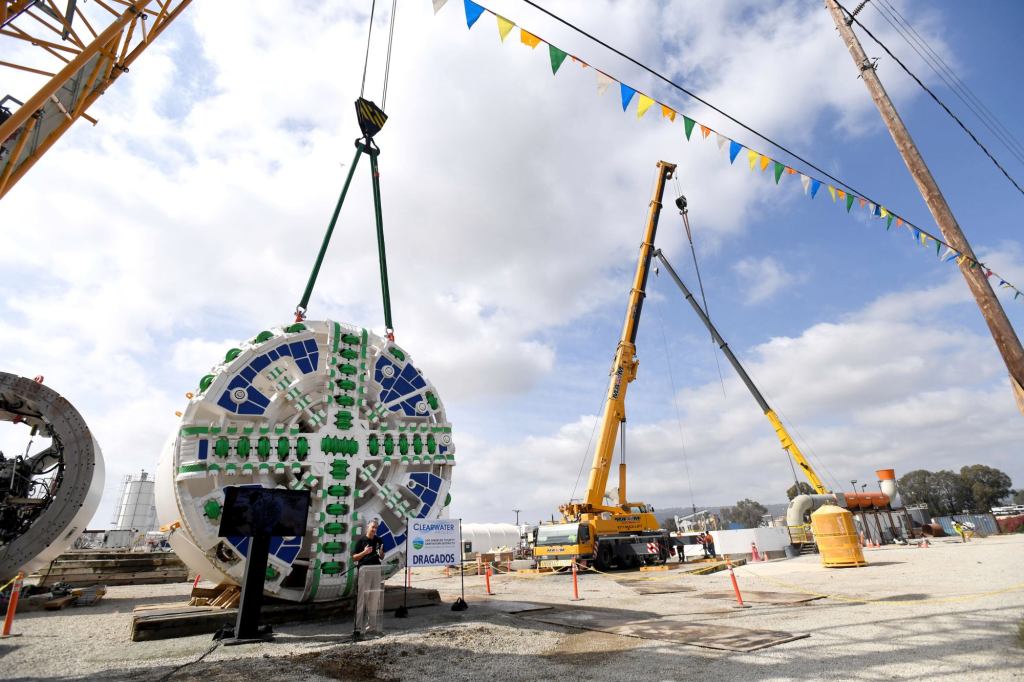After more than a decade of meticulous planning, a massive $630 million underground tunneling project is finally about to launch this summer.
On Thursday, April 15, engineers and city officials gathered at the foot of the two-story high electric tunneling machine — if not for COVID-19 restrictions, the event would have included a much larger crowd — to talk about the importance of replacing two aging wastewater pipes installed in 1937 and 1958. Currently, 77 of Los Angeles County’s 88 cities rely on the antiquated pipelines that take treated wastewater from the Los Angeles County Sanitation Districts’ Joint Water Pollution Control Plant, in Carson, to the ocean off of San Pedro’s Royal Palms Beach.
“This project has been a long time in the making,” said Cathy Warner, the Sanitation Districts’ board chair and a Whittier City Council member. “As Californians, we enjoy a great standard of living in large part due to the quality of our infrastructure. This project is an investment to maintain that standard of living and preserve the environment for our grandkids.”
In June, the giant boring machine, designed and made in Germany specifically for the project, will be lowered down a shaft, where it will be positioned to begin its 7-mile, underground journey below the streets of the South Bay and Harbor Area. The project will replace those aging pipes — which are 8 feet and 12 feet in diameter, respectively — with one 18-foot wide, pipe that can handle the water flow.
The machine, which expands to the length of more than two football fields and will be operated by a trained crew, will move about 30 to 50 feet a day, five days a week. Yet, it won’t reach its south-facing coastline destination for three and a half years. With other work also needed to connect the new pipes to the existing ocean outfall with undersea pipelines, the entire project isn’t expected to be complete until 2027.
Planning for the project began in 2006 when engineers realized the old pipes could not continue functioning without a breach, especially serving what is still a growing population. The situation was especially complicated, though, as the condition of the pipes was nearly impossible to gauge due to the need to keep a constant flow of water.
In 2011, Basil Hewitt, a senior engineer and public information supervisor with the Sanitation District, put it this way: “Imagine you have a car and it’s running fine, but you can’t open the hood. And you’ve driven 12,000 miles without checking the oil.”
The existing pipelines also were not built to current earthquake standards.
Other work will also be ongoing throughout the project at the Carson shaft location, on Figueroa Street near Lomita Avenue. A 20-foot-high noise barrier will be erected around the site.
At Royal Palms Beach, the new tunnel will connect to the existing ocean outfalls. Work at that location will take about two and a half years to complete. Beach and parking access will remain open, with work scheduled from Monday through Friday.
While the need for the project wasn’t questioned, many community members early on were concerned about how it would impact neighborhoods. An alternative route that would go under Terminal Island was eventually rejected due to much higher costs. Three of the four existing outfalls at Royal Palms remain in good working order, Hewitt said, making the Carson-to-San Pedro route the most logical and least costly.
More than 500 community meetings were held before the current proposal — which included some additional bends and turns in order to keep the boring almost exclusively underneath city streets and away from homes and other buildings — was approved on Nov. 28, 2012, by the Los Angeles County Sanitation Districts.
The virtual news conference on Thursday also included beamed-in remarks from Los Angeles City Councilman Joe Buscaino, a Sanitation Districts board member, and Torrance Mayor Patrick Furey, who is board chairman for Sanitation District 5 and the South Bay Cities Sanitation District.
Students who were finalists in a naming contest for the boring machine also were acknowledged.
Hanna Hsu, a fifth-grader at Highland Oaks Middle School in Arcadia, provided the winning name of “Rachel,” after Rachel Carson, the author of the 1962 book “Silent Spring” which is now credited with starting the present-day environmental movement.
Other finalists, whose artwork will accompany the machine on its long underground journey, were: Dagny Tang, a second grader at Montemalaga Elementary School in Palos Verdes Estates; Ashanti Perez, a seventh grader at Thomas Starr King Middle School in Los Angeles; and Emilie Tyler, a senior at Palos Verdes High School in Palos Verdes Estates.
The boring machine was especially built to work with the types of rock and soil it will encounter below the South Bay land surface. The machines, which replaced the need to do underground blasting by crews, have also been used for L.A.’s subway system.
Among those on hand Thursday was Carola Wenzel, a civil engineer from the German plant that constructed the machine. She will be onsite to help oversee the project.
Maintenance blocks, including one on North Gaffey Street in San Pedro, will be used for needed work on the machine’s blades and other parts as work goes on.
Concrete liners in segments, manufactured in Palmdale, will be installed as the machine moves forward, securing the tunnel infrastructure.
But officials said there will be no noticeable sounds or other signs above ground as the machine makes its way underground through the various communities. Trucks that will carry in the concrete tunnel segments and carry away dirt will use primarily the 110 Freeway to Sepulveda and then Figueroa Street to reach the sanitation shaft site.
Current plans call for the machine to be lowered into the main shaft sometime in June with the actual tunneling process to start in early August.









